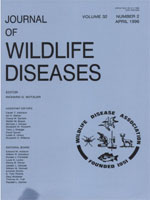Mandibles from 1104 red deer (Cervus elaphus), 147 moose (Alces alces), and 453 roe deer (Capreolus capreolus), collected between 1990 and 1993 in the vicinity of seven Norwegian aluminum smelters, were examined for dental fluorotic and osteofluorotic lesions. The metacarpal or metatarsal bones from 214 of these cervids also were evaluated. Dental fluorotic lesions occurred in all three cervid species. Prevalence of dental fluorosis was generally low at the various locations, with the exception of Årdal, where 15% of the cervids examined were affected. Only sporadic cases of severe dental fluorotic lesions were diagnosed. All red deer yearlings (1.5 yr) with mandibular fluorine (F) levels exceeding 2,000 ppm F, had dental fluorosis. However, the lowest skeletal fluorine level found in a fluorotic animal of this age was 1,355 ppm F. Gross osteofluorosis occurred in only three cervids, all with mandibular fluorine residues >8,000 ppm F. Hence, generalized fluorosis was not a prominent feature in the material studied.
How to translate text using browser tools
1 April 1996
FLUORIDE EXPOSURE IN CERVIDS INHABITING AREAS ADJACENT TO ALUMINUM SMELTERS IN NORWAY. II. FLUOROSIS
Turid Vikøren,
Gudbrand Stuve

Journal of Wildlife Diseases
Vol. 32 • No. 2
April 1996
Vol. 32 • No. 2
April 1996
Alces alces
Capreolus capreolus
cervids
Cervus elaphus
dental fluorosis
Fluorine
osteofluorosis




